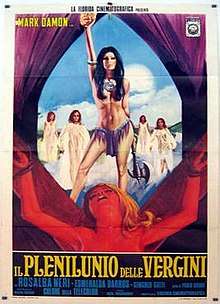The Devil's Wedding Night
| The Devil's Wedding Night | |
|---|---|
 | |
| Directed by | |
| Produced by | Franco Gaudenzi[1] |
| Screenplay by |
|
| Story by |
|
| Starring |
|
| Music by | Vasil Kojukaroff[1] |
| Cinematography | Joe D'Amato[1] |
| Edited by |
|
Production company |
Virginia Cinematografica[1] |
| Distributed by | Florida Cinematografica |
Release date |
|
Running time | 94 minutes[1] |
| Country | Italy[1] |
| Language | Italian[2] |
| Box office | ₤117.150 million |
The Devil's Wedding Night (Italian: Il plenilunio delle vergini, lit. 'Full Moon of the Virgins') is a 1973 Italian horror film.[2]
Plot
A man goes to a castle in the Carpathian Mountains. The villagers tell him that there have been instances when five virgins go to the castle and never return. Arriving in the castle, he finds satanic activity going on.
Cast
- Mark Damon: Karl Schiller
- Rosalba Neri: La Contessa Dolingen de Vries (as Sara Bay)
- Esmeralda Barros: Lara the Zombie
- Xiro Papas: The Vampire Monster (as Ciro Papas)
- Gengher Gatti: The Mysterious Man (as Alexander Getty)
- Enza Sbordone: Tanya the Innkeeper's Daughter (as Francesca Romana Davila)
- Carlo Gentili: The Innkeeper (as Mort Baxter)
- Giorgio Dolfin: First Villager at Inn (as George Dolfin)
- Stefano Oppedisano: Second Villager at Inn (as Stephen Hopper)
Style
In his book Vampire Films of the 1970s, Gary A. Smith described the film as "a throwback to gothic horror" and that it appeared to be influenced by Hammer vampire films of the 1970s, specifically Twins of Evil.[3]
Production
Producer Franco Gaudenzi stated that The Devil's Wedding Night was a film that actor Mark Damon "wanted to do, it was a script he had, it was his creature."[1] Gaudenzi expanded on this, stating Damon was planning on selling the film to an American production company who was interested in distributing it.[4] The screenplay is credited to Walter Bigari and Batzella, while the copy of the screenplay which is close to finished product with many technical indications only credits only Batzella's name.[4] This version of the screenplay includes a prologue involves the Countess summoning the forces of evil while in her castle nude women are tied to a column with their throats being slashed which is not in the film.[4] When choosing the director, Gaudenzi hired Luigi Batzella, stating that he was often in their office discussing film ideas with Joe D'Amato and Bruno Mattei.[4]
The Devil's Wedding Night began shooting on July 31, 1972.[5] It was shot on location at Piccolomini castle in Balsoranao.[5] Gaudenzi stated that despite only Batzella getting a credit on the film, it was directed by both D'Amato and Batzella, as Batzella had D'Amato reshoot some scenes.[4] Damon was impressed with D'Amato, and recommended him to Roger Corman to work on the American production The Arena.[4][5] Rosalba Neri spoke later about Batzella's direction on set stating that she "never understood him. It was like there were two of them, going different directions...and rarely meeting. A bit schizophrenic, indeed."[5]
Release
The Devil's Wedding Night was released in Italy by Florida Cinematografica on 14 March 1973.[1] The films erotic content was cut by Italian censors who demanded that a sex scene be shortened and that "all scenes be eliminated where the man kisses the lower part of the woman's body."[5] The film grossed a total of 117,115,000 Italian lire domestically in Italy.[1]
See also
References
Footnotes
Sources
- Browning, John Edgar; Picart, Caroline Joan (Kay) (2011). Dracula in Visual Media: Film, Television, Comic Book and Electronic Game Appearances, 1921–2010. McFarland & Company. ISBN 0786462019.
- Curti, Roberto (2017). Italian Gothic Horror Films, 1970–1979. McFarland. ISBN 1476629609.
- Paul, Louis (2005). Italian Horror Film Directors. McFarland. ISBN 978-0-7864-8749-3.
- Smith, Gary A (2017). Vampire Films of the 1970s: Dracula to Blacula and Every Fang Between. McFarland. ISBN 147662559X.